Overview
The Revenova TMS Analytics App is a data visualization tool built using Salesforce CRM Analytics (formerly Tableau). It includes four pre-built dashboards to capture some of the basic metrics that matter to logistics businesses. Dashboard examples are provided below.
Critical Customer Responsibilities
Make sure you maintain your security profiles and sharing settings so that the appropriate capabilities and data are exposed to your various user groups.
Salesforce CRM and Platform Online Help
Salesforce provides an extensive library of online text and video describing the capabilities of the Force.com platform and the CRM (and other) products it provides. Please click on the Help links and icons present on every page of the application to access these resources.
Managed Package Installation
The Revenova Analytics package is not compatible with the Revenova 7.12 TMS package version. Upgrade to the Revenova Fall ‘24 TMS and Analytics packages to ensure compatibility.
Setup
A subscription to the Revenova TMS is required before installing the Revenova TMS Analytics App. Please see the Revenova TMS Installation Guide for basic instructions on how to install the Revenova TMS into an existing Salesforce environment.
Obtain the TMS Analytics installation URL and password from your Revenova representative. Log in to the Revenova instance.
In the upper-right corner of the screen, click the Setup icon.
Navigate to the Users page and find the User record for the person installing the package.
Under the Permission Set Assignments section, click the Edit Assignments button.
Add the CRM Analytics Platform Admin permission set to the Enabled Permission Sets column.
Click Save.
Assigning the CRM Analytics Platform Admin permission set automatically assigns the CRM Analytics Plus license to the same user.
Navigate to the Analytics page and select the Getting Started link.

Click the Enable CRM Analytics button.
Refresh the browser.
From the Analytics page, select the Settings link.
Check the Enable Data Sync and Connections setting.
Click Save.

Navigate to the Data Integration Rules page.
Select Geocodes for Account Shipping Address.
Click the Activate button.
Install
Paste the link URL into the address bar and press Enter. (everything after force.com on both the package link and the URL)
Enter the installation key and select Install for All Users. Click Install.
A message displays indicated the Installation completed. An email is sent when the process is complete. Click Done.
In the upper-right corner of the screen, click the Setup icon.
Navigate to the Users page and verify that an integration user with the Analytics Cloud Integration User profile was created.
Navigate to the Installed Packages page and confirm TMS Analytics is listed.
For Production Installation Only:
Next to TMS package, click Manage Licenses. In the Licensed Users list, click the Add Users button. Assign the Analytics Cloud Integration User.
Next to TMS Analytics package, click Manage Licenses. In the Licensed Users list, click the Add Users button. Assign Analytics Cloud Integration User.
Navigate to the Permission Sets page and click the New button.

Name the new permission set Analytics Install User and allow the API name to populate in the box below.
Click Save.
In the list of Apps, select the Object Settings link.

Assign Read permissions to this permission set for all fields of the following objects:
Select the object, then click the Edit button and check the Read box. After enabling, click Save.Account
Equipment Type
Load
Stop
Transportation Profile
User
Navigate to the Users page. Assign the Analytics Install User permission set to the Analytics Cloud Integration User. Click Save.

Return to the Auto-Installed Apps page under Setup, Analytics.
Select the Requests tab and find the TMS Analytics app with a Skipped status.
From the drop-down menu, choose Try Again.
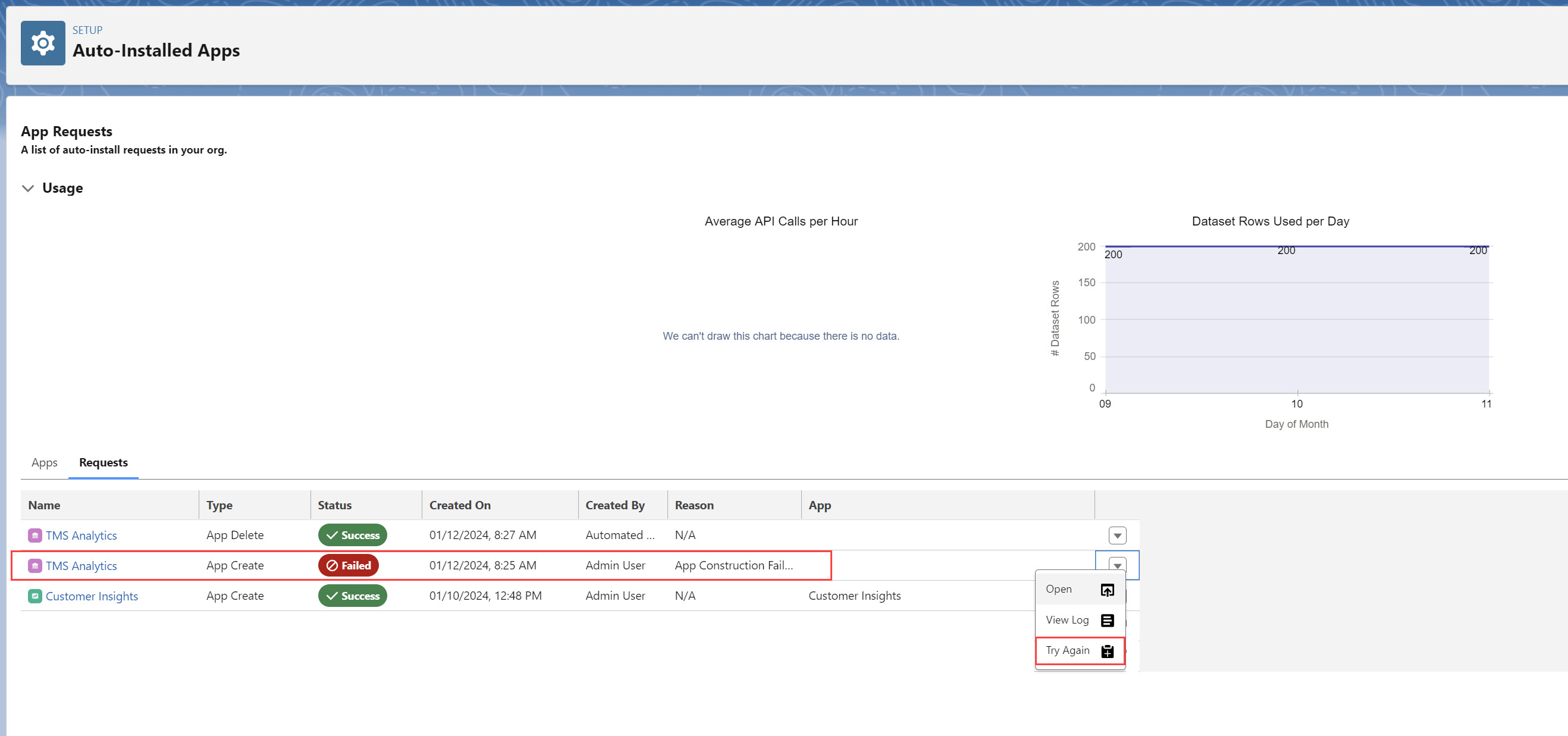
Refresh the web browser to monitor the progress of the installation. When the status changes to Success, the app is installed.
If the App status changes to Failed or Skipped, see Troubleshooting below.
Navigate to the App Launcher. Search for and choose Analytics Studio.
On the left side of the screen, select Browse.
Under Apps, select TMS Analytics.

Click the Setup menu and select Data Manager.
On the left side of the screen, choose the Connections tab.
Locate the SFDC_LOCAL connection tile. Click the drop-down menu and select Run Now.

The object syncing begins and when each completes the Status column displays Successful for each object.
On the left side of the screen, select the Recipes tab.
Locate Revenova_Analytics All Loads with All Fields. From the drop-down menu, select Run Now.

When the recipe completes, the analytics dashboards are ready for use.
If there are issues with the installation process, see the Troubleshooting section below.
Scheduling Data Sync and Recipes
This section should be completed by a user, not a member of the Revenova Team. The setup below is based on user preference for frequency of data pulls.
From the App Launcher, search for and open Analytics Studio.
Click the Setup gear to open the drop-down menu and select Data Manager.

On the left side, find the tab for Connections.
On the Input tab, find the SFDC_LOCAL connection. Click on the drop-down menu and select Schedule.
In the modal, decide how often TMS Analytics collects new data.
Click Save.
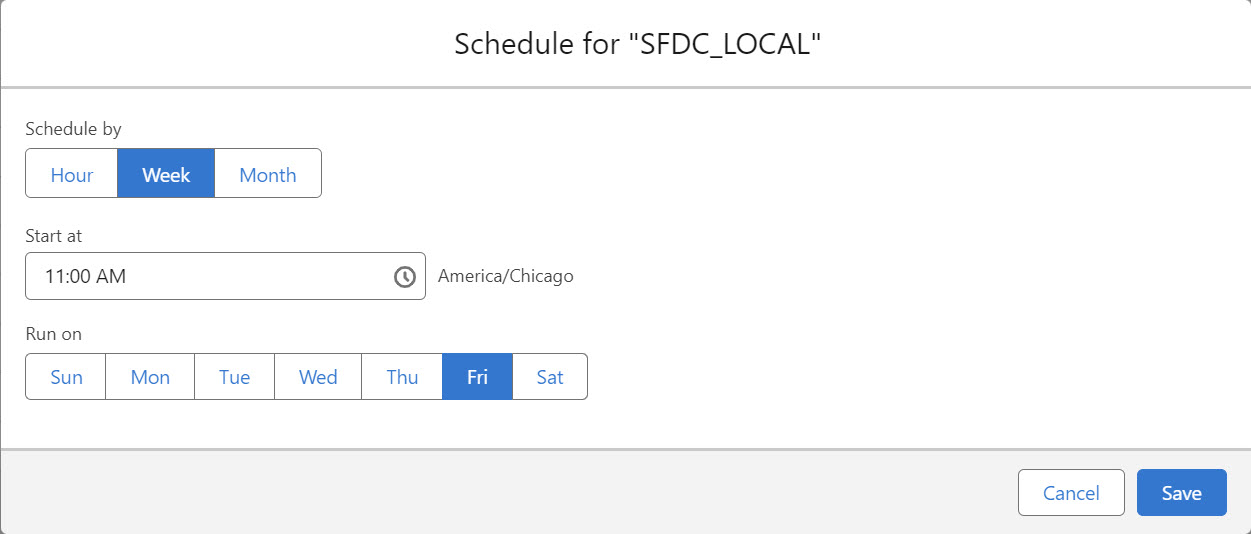
From the list of recipes, locate the recipe titled Revenova_Analytics All Loads with All Fields.
Click the drop-down menu on the right side of the Revenova_Analytics All Loads with All Fields row.
Select Schedule.
Using the modal, set how often the recipe processes the data for the dashboards.
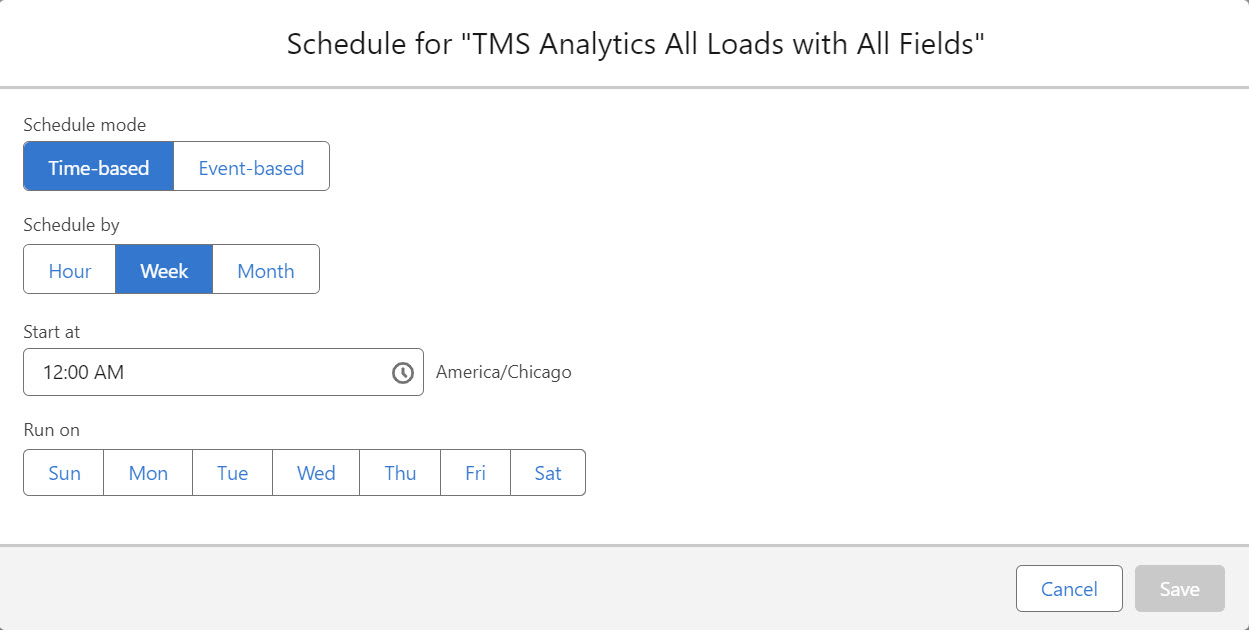
Ensure that the recipe is schedule to run AFTER the SFDC_LOCAL connection.
Dashboards
Business Overview
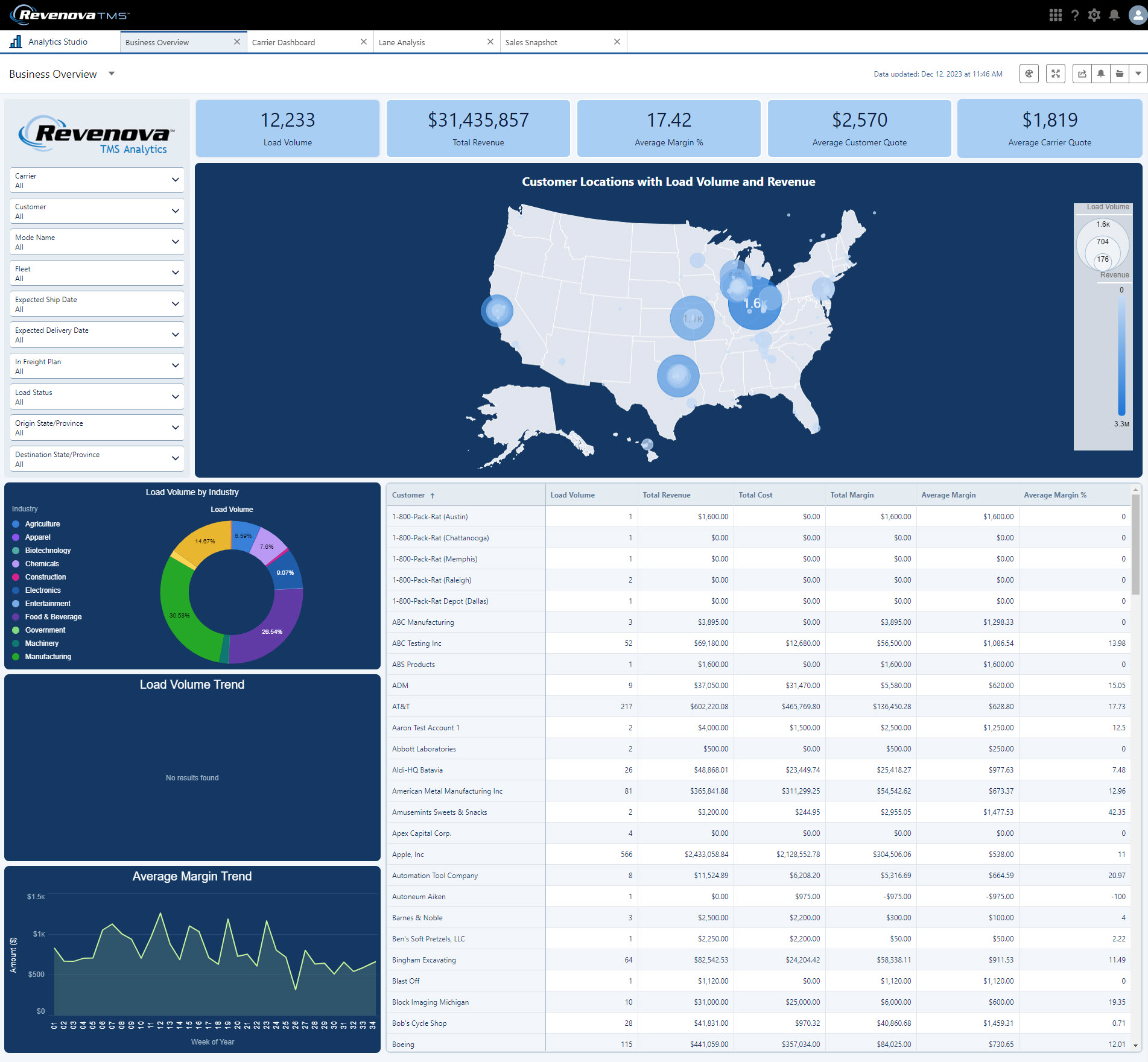
.gif)
Carrier Performance
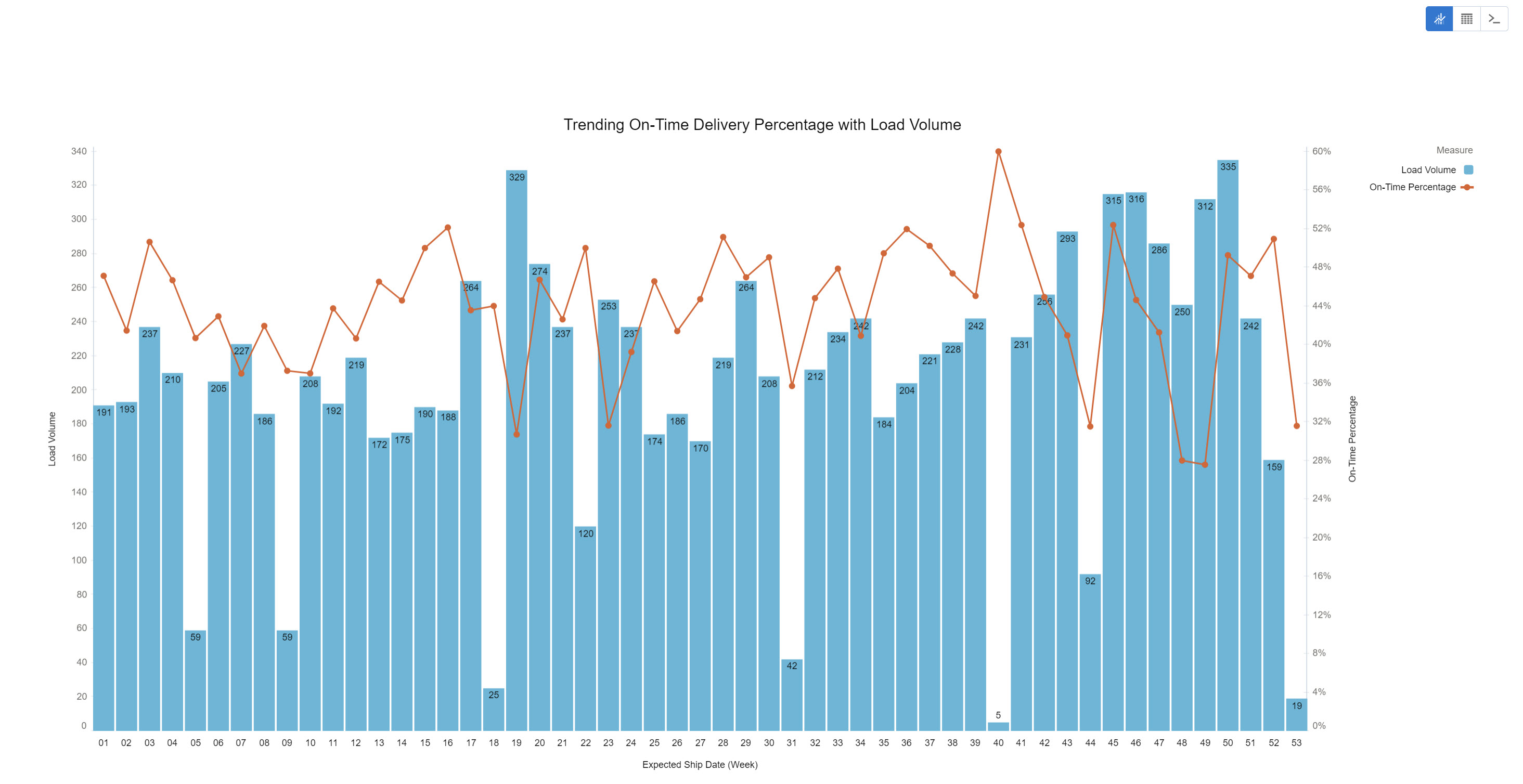
Lane Analysis
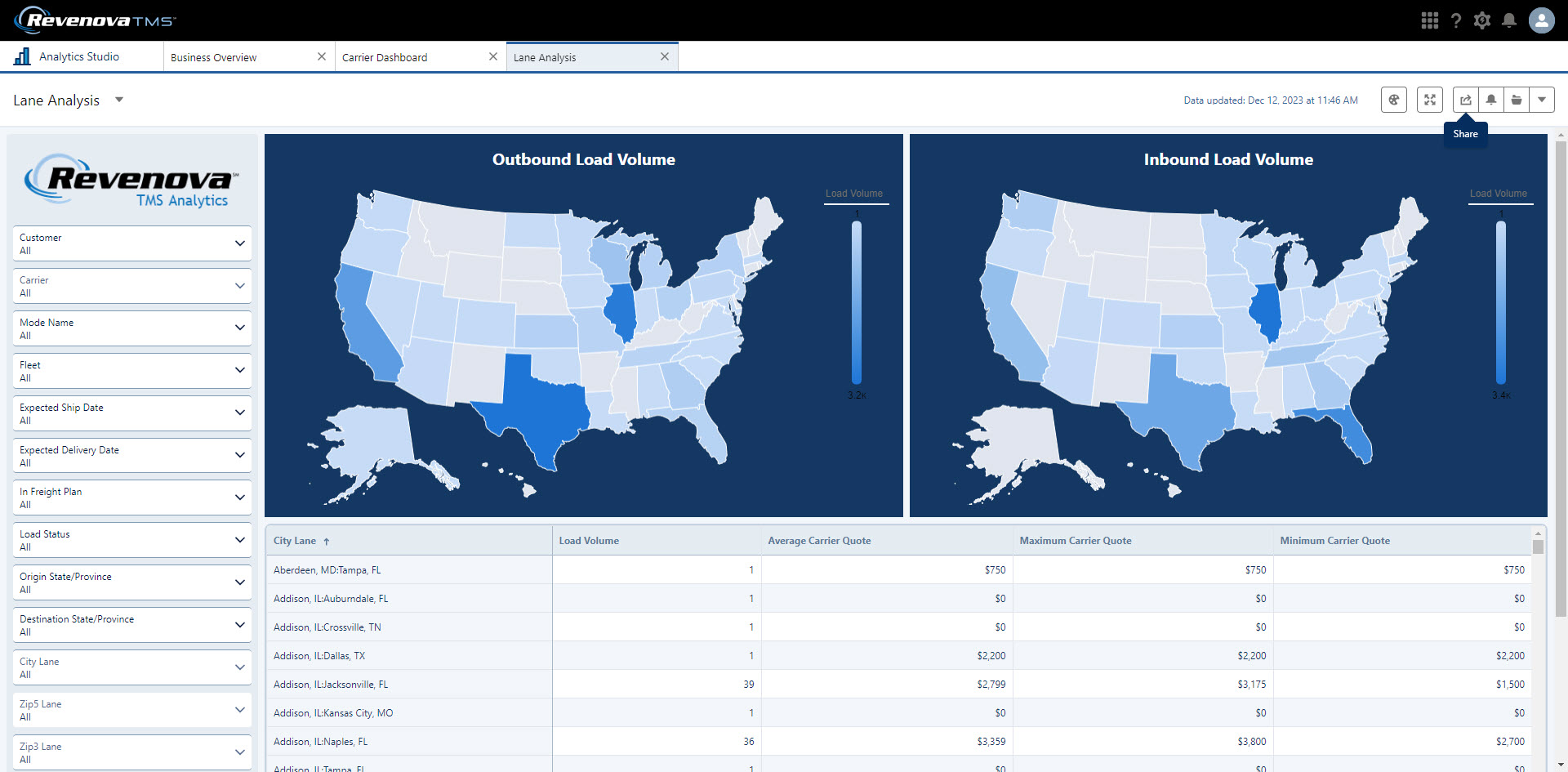
.gif)
Sales Snapshot
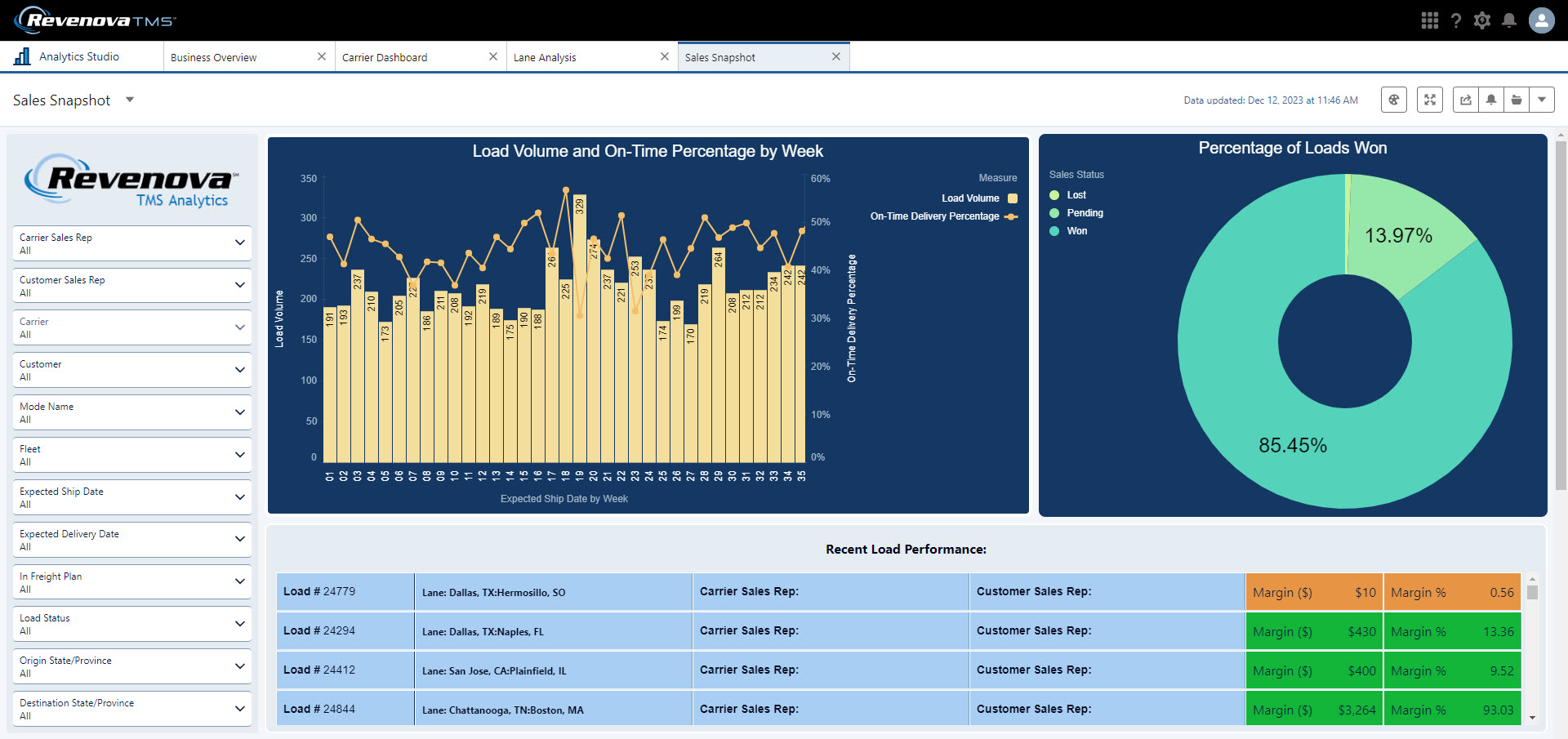
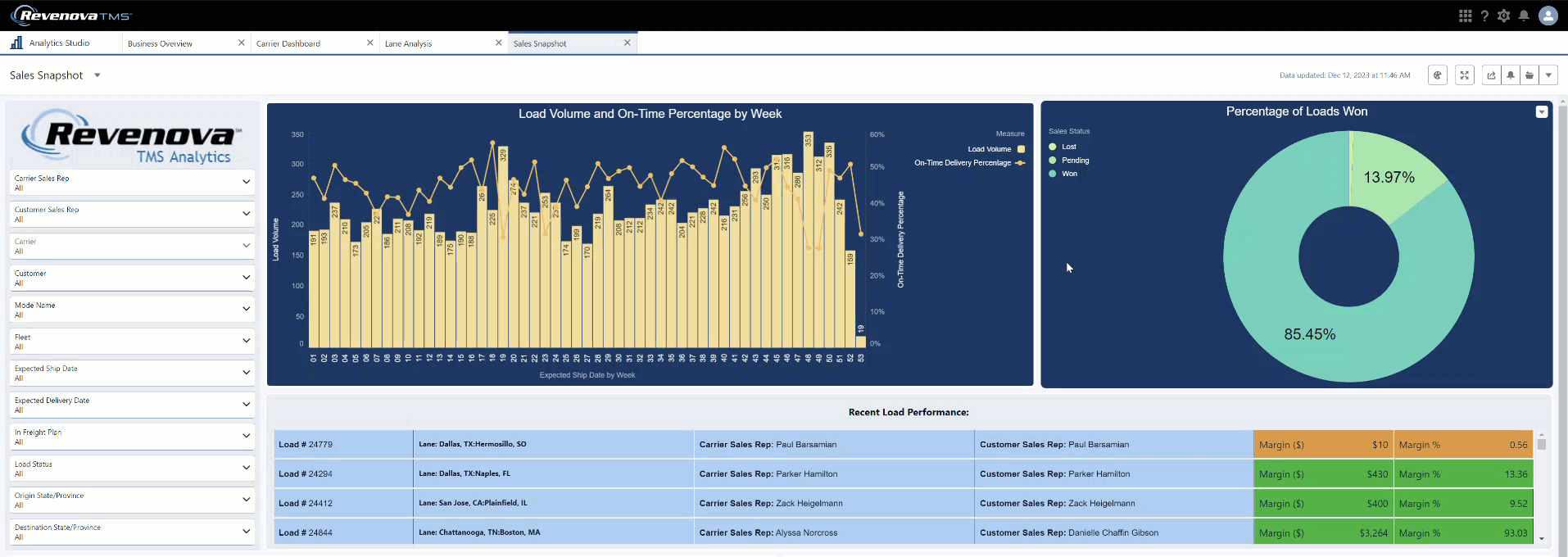
Build and customize additional dashboards as necessary. View Salesforce Dashboard help for more information.
Dashboard Column Labels
Consult the table below to correct the field labels for each of the four provided dashboards. Enter the corrected field label for each label provided in the table.
Click the Edit button in the top left corner of the screen. This opens the dashboard Edit mode.

Double click on the component (a chart) listed in the second column (Component Name) of the table. This allows for editing the query.
Locate each field from the third column (Original Field Label) of the table. Click the drop-down menu button on the right side of the box.
In the drop-down menu, select Rename Column.
.jpg)
Enter the corresponding field from the fourth column (Corrected Field Label) of the table.
When the corrected field label is entered, choose Save.
Click Update at the bottom of the Query Editor.
Click Save in the top-right corner of the screen to complete editing the dashboard.
Dashboard | Component Name | Original Field Label | Corrected Field Label |
|---|---|---|---|
Business Overview | Customer Locations with Load Volume and Revenue | Count of Loads | Load Volume |
Sum of Customer Quote Total | Total Revenue | ||
Load Volume By Industry | Count of Loads | Load Volume | |
Load Volume Trend | Count of Loads | Load Volume | |
Average Margin Trend | Average of Margin % (Quoted) | Average Margin % | |
Customer Account Name Table | Sum of Customer Quote Total | Total Revenue | |
Count of Loads | Load Volume | ||
Sum of Carrier Quote Total | Total Cost | ||
Sum of Margin (Quoted) | Total Margin | ||
Average Margin (Quoted) | Average Margin | ||
Average Margin % (Quoted) | Average Margin % | ||
Carrier Performance | Trending On-Time Delivery Percentage with Load Volume | Count of Loads | Load Volume |
B/A | On-Time Percentage | ||
On-Time Percentage by Carrier | B/A | On-Time Percentage | |
City Lane Table | Count of Loads | Load Volume | |
Average of Carrier Quote Total | Average Cost | ||
C/A | On-Time Percentage | ||
Carrier Account Name Table | Count of Loads | Load Volume | |
Sum of Carrier Quote Total | Total Cost | ||
Median of Carrier Quote Total | Median Carrier Cost | ||
D-E | Quote to Invoice Difference (Q-I) | ||
Lane Analysis | Outbound Load Volume | Count of Loads | Load Volume |
Inbound Load Volume | Count of Loads | Load Volume | |
City Lane Table | Count of Loads | Load Volume | |
Avg of Carrier Quote Total | Average Carrier Cost | ||
Max of Carrier Quote Total | Max Carrier Cost | ||
Min of Carrier Quote Total | Min Carrier Cost | ||
Sales Snapshot | Load and On-Time Percentage by Week | Count of Loads | Load Volume |
B/A | On-Time Percentage | ||
Percentage of Loads Won | Count of Loads | Load Volume | |
Carrier Sales | Count of Loads | Load Volume | |
Avg of Margin % (Quoted) | Average Margin % | ||
Avg of Margin (Quoted) | Average Margin | ||
Unique of Transportation Profile | Number of Accounts | ||
Customer Sales | Count of Loads | Load Volume | |
Avg of Margin % (Quoted) | Average Margin % | ||
Avg of Margin (Quoted) | Average Margin | ||
Unique of Transportation Profile | Number of Accounts |
Sharing Dashboards
To share a dashboard, navigate to Analytics Studio.
Click Browse on the navigation panel on the left side of the screen.
Select Apps at the top of the page.
Find TMS Analytics in the table and click the drop-down menu button and choose Share.

In the Sharing modal, select the users to share the dashboards contained in TMS Analytics.
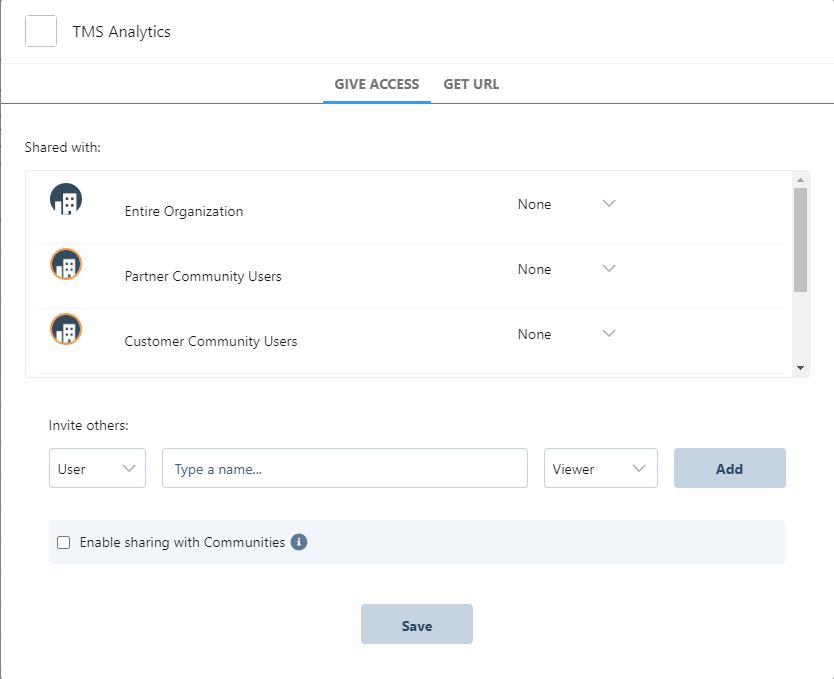
Add individual users, the entire organization, or other user groups. Click Add for each. In most cases, the Viewer type is selected.
When finished, click Save.
Managing Licenses
Revenova TMS Analytics includes two license types.
Analytics Studio (Manage, Create, Share the Revenova TMS Analytics package).
Analytics View Only Embedded App (View shared dashboards).
License | Purpose | Permissions | To Assign |
|---|---|---|---|
TMS Analytics App License | In production only, grants access to the objects and fields associated with the TMS Analytics package. | View the TMS Analytics app in the Analytics Studio. | Installed Packages → Manage Licenses |
Analytics Platform | Access all analytics features. | Access Adoption Analytics Templates and Apps Access Sales Cloud Analytics Templates and Apps Access Service Cloud Analytics Templates and Apps Add CRM Analytics Remote Connections Add Recipients to CRM Analytics Notifications Allow access to Analytics Watch Audit Autonomous Insights Observations Create and Edit CRM Analytics Dashboards Create CRM Analytics Apps Download CRM Analytics Data Edit CRM Analytics Dataflows Edit Dataset Recipes Enable Data Prep Pilot Features Explore External Data Directly Manage Analytics Watch Data Manage Autonomous Insights Data Privacy Manage CRM Analytics Manage CRM Analytics Custom Maps Manage CRM Analytics Private Assets Manage CRM Analytics Templated Apps Share CRM Analytics Images Subscribe to CRM Analytics Assets Trend Report Data in CRM Analytics Upload External Data to CRM Analytics Use CRM Analytics Use CRM Analytics Templated Apps | Users → Find the user → Permission Set License Assignments → Edit Assignments |
CRM Analytics Platform User | User of the Analytics platform. | CRM Analytics Platform User - Includes the user permission to view Sales and Service Analytics. | Users → Permission Sets |
CRM Analytics Platform Admin | Administrator over Sales and Service Analytics | CRM Analytics Platform Admin - Includes the user permission to create and manage Sales and Service Analytics. | Users → Permission Sets |
Analytics View Only Embedded App | Allow access to view-only licensed embedded apps and assets. | Access to View-Only Licensed Templates and Apps | Users → Permission Set License Assignments |
Troubleshooting
Verify that the TMS Analytics package installed correctly.
Navigate to Setup → Apps → Packaging → Installed Packages.

- Verify that the post-install scripts completed. Run the following query in the developer console:select id, rtms8__had_error__c, rtms8__process_name__c, rtms8__error_description__c from rtms8__AsyncApexLog__cIf the query returns rows, an error has occurred. Read the error description for more information.
Check the status of the Revenova Analytics/App Create record.
Navigate to Setup → Feature Settings → Analytics → Apps → Auto-Installed Apps.Click the Requests tab.
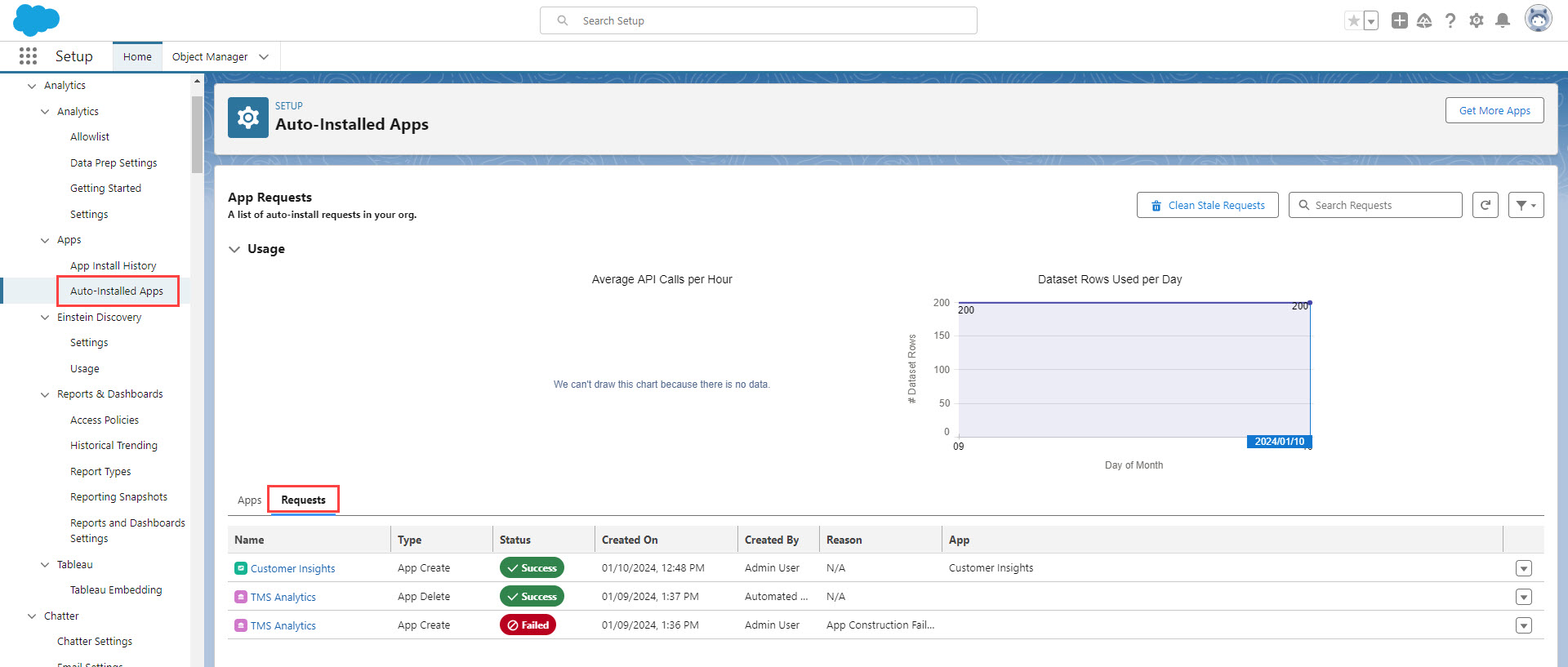
Find the row for TMS Analytics of Type App Create. Click the drop-down button and select View Log.
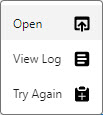
If the Log contains a Data Sync failure:
- Navigate to App Launcher → Data Manager → Jobs Monitor → Job. Click the error symbol at the top of the screen to see error messages.
- Re-run the connections.Navigate to App Launcher → Data Manager → Connections.

- On the SFDC_LOCAL tab click the drop-down and select Run Now.
- OR, for each failed connection, select it and from the drop-down select Run Now.
Verify that the embedded app installed correctly.
Navigate to Setup → Feature Settings → Analytics → Apps → Auto-Installed Apps.
Click the Requests tab.
If the status is Skipped or Failed, click the drop-down button and select View Log.

Failed Log contains:
The integration user does not have access to certain fields.
- Return to the profile or permission set created and assigned to the installing user.
- Grant Read access for the missing fields listed in the log.
- Select the menu button and click Try Again.Navigate to the Profile or Permission Set created for the installing user. Grant read access for the missing fields contained in the log. Select the menu button and click Try Again.
Skipped Log contains:Verify the TMS Analytics application license is assigned to the Analytics Integration User. If not, add the license to the user and retry the application installation.